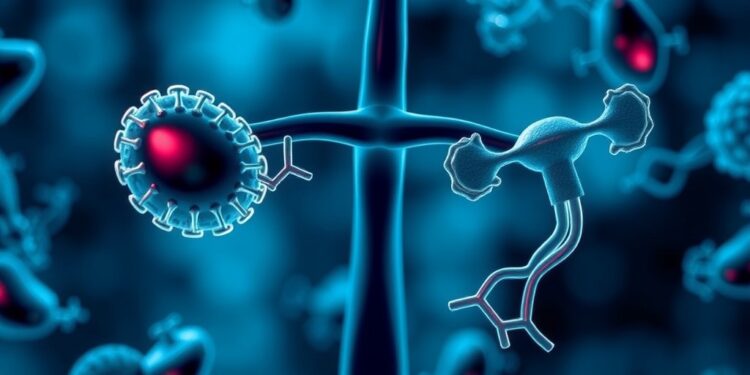Scientific advancements often unfold in unexpected areas, yielding fresh insights that may reshape our understanding of health conditions. A groundbreaking study from the University of California, San Francisco, reveals a novel pathway through which female hormones may provide relief from chronic pain—an affliction that affects a significant portion of the population. By prompting certain immune cells to produce opioids, these hormones play a crucial role in blocking pain signals from reaching the brain.
Central to this discovery are T regulatory immune cells, or T-regs, traditionally recognized for their role in modulating inflammation. These immune cells, primarily situated in the meninges, the protective membranes encasing the brain and spinal cord, have now been linked to pain management. This transformative insight highlights the meninges not only as a safeguard for the central nervous system but also as a vital communication hub between the immune system and sensory neurons.
The research identified a fascinating sex-dependent mechanism. Female hormones—specifically estrogen and progesterone—appear to catalyze the T-regs’ production of enkephalin, a natural painkiller. This process effectively blunts the transmission of pain signals, particularly in females, who were found to rely heavier on T-regs for pain management compared to their male counterparts. Such a profound difference in the way pain is processed between genders raises critical questions about the design and efficacy of pain treatments available today.
In their investigations, the researchers employed a toxin to selectively eliminate T-regs in laboratory mice, which yielded notable outcomes. Female mice displayed increased sensitivity to pain when deprived of these immune cells, while male mice appeared unaffected. This divergence suggests that the pain management systems between sexes operate differently, indicating a complex interplay between gender and immune cell function.
This study not only elucidates the biological underpinnings of pain but also offers potential clinical implications. A better understanding of how sex hormones influence immune pathways related to pain could inform personalized treatments. For instance, female patients experiencing chronic pain, particularly those who are postmenopausal and no longer producing estrogen and progesterone, may benefit from targeted therapies that acknowledge these hormonal influences. As observed, certain migraine treatments already exhibit sex-specific efficacy, and this research could pave the way for more nuanced approaches to pain management.
Another intriguing prospect raised by the researchers is the potential of engineering T-regs to produce enkephalin consistently. If successful, this strategy could drastically improve pain control for individuals suffering from chronic pain conditions, a problem that currently afflicts nearly 20% of the American population. The promise of such innovative approaches emphasizes the urgency for further exploration of this area of study.
As the relationship between hormones, immune responses, and pain perception becomes clearer, a shift in the pain management discourse appears inevitable. To date, much of pain treatment has centered on commonly prescribed medications, yet this research highlights an essential gap in addressing the underlying biological differences that dictate treatment responses.
Furthermore, the study underlines the necessity for additional research aimed at unraveling these complex interactions in the context of chronic pain. Deciphering the precise mechanisms through which hormones modulate T-reg activity and subsequently pain signaling could empower clinicians with new therapeutic options. This could involve not only pharmacological solutions but also lifestyle interventions that optimize hormonal balance in women.
In summary, the remarkable discovery surrounding T regulatory cells and their sex-dependent function in modulating pain underscores the need for a paradigm shift in how we approach chronic pain management. It suggests a future where treatments are tailored based on biological and hormonal profiles, ultimately offering a more effective means of alleviating pain for diverse populations. As science progresses, staying attuned to these developments will be vital for both healthcare providers and patients alike.
In the realm of scientific inquiry, each new finding sparks a broader conversation about health and treatment options. This study serves as a poignant reminder of the interconnectedness of immune function, gender differences, and pain perception, revealing avenues for innovative therapeutic interventions that could one day enhance the quality of life for countless individuals grappling with chronic pain.
As this research unfolds, the anticipation of discovering more specific pathways and potential treatments builds a foundation for hope. The collaboration among researchers across disciplines will be key in translating laboratory discoveries into tangible, clinical outcomes. The road ahead reflects an exciting time in biomedical research, with the promise of changing the way we approach chronic pain management fundamentally.
This represents a significant leap toward understanding one of the most prevalent and challenging health issues that affects individuals across various demographics. By recognizing and addressing the biological nuances that influence pain, we open up a path for more strategic and sophisticated treatment options that cater to the unique needs of both women and men.
In conclusion, the research conducted by the scientists prompts us to rethink conventional methodologies regarding chronic pain treatments. It highlights the essential need for a more personalized approach rooted in our understanding of biological diversity. As we stand on the brink of potential new therapies that stem from this understanding, it becomes increasingly important to remain engaged in this narrative of scientific exploration and its implications for health and well-being.
Subject of Research: The role of female hormones and T regulatory immune cells in chronic pain management
Article Title: New Mechanism Discovered on How Female Hormones Help Manage Chronic Pain
News Publication Date: April 4, 2023
Web References: Science Journal
References: Not available
Image Credits: Not available
Keywords: Immune cells, chronic pain, estrogen, progesterone, pain management




